Page 158 of 192
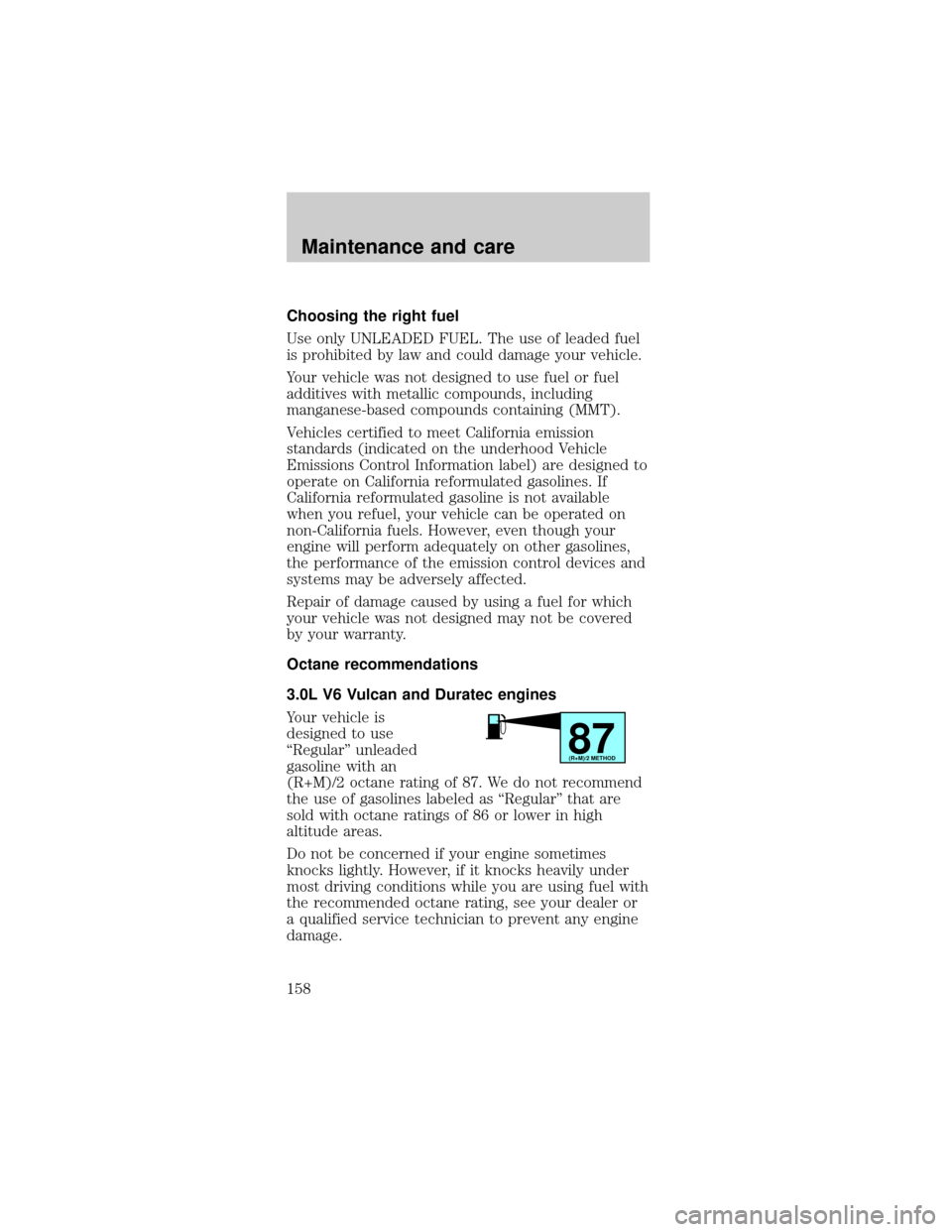
Choosing the right fuel
Use only UNLEADED FUEL. The use of leaded fuel
is prohibited by law and could damage your vehicle.
Your vehicle was not designed to use fuel or fuel
additives with metallic compounds, including
manganese-based compounds containing (MMT).
Vehicles certified to meet California emission
standards (indicated on the underhood Vehicle
Emissions Control Information label) are designed to
operate on California reformulated gasolines. If
California reformulated gasoline is not available
when you refuel, your vehicle can be operated on
non-California fuels. However, even though your
engine will perform adequately on other gasolines,
the performance of the emission control devices and
systems may be adversely affected.
Repair of damage caused by using a fuel for which
your vehicle was not designed may not be covered
by your warranty.
Octane recommendations
3.0L V6 Vulcan and Duratec engines
Your vehicle is
designed to use
ªRegularº unleaded
gasoline with an
(R+M)/2 octane rating of 87. We do not recommend
the use of gasolines labeled as ªRegularº that are
sold with octane ratings of 86 or lower in high
altitude areas.
Do not be concerned if your engine sometimes
knocks lightly. However, if it knocks heavily under
most driving conditions while you are using fuel with
the recommended octane rating, see your dealer or
a qualified service technician to prevent any engine
damage.
87(R+M)/2 METHOD
Maintenance and care
158
Page 159 of 192
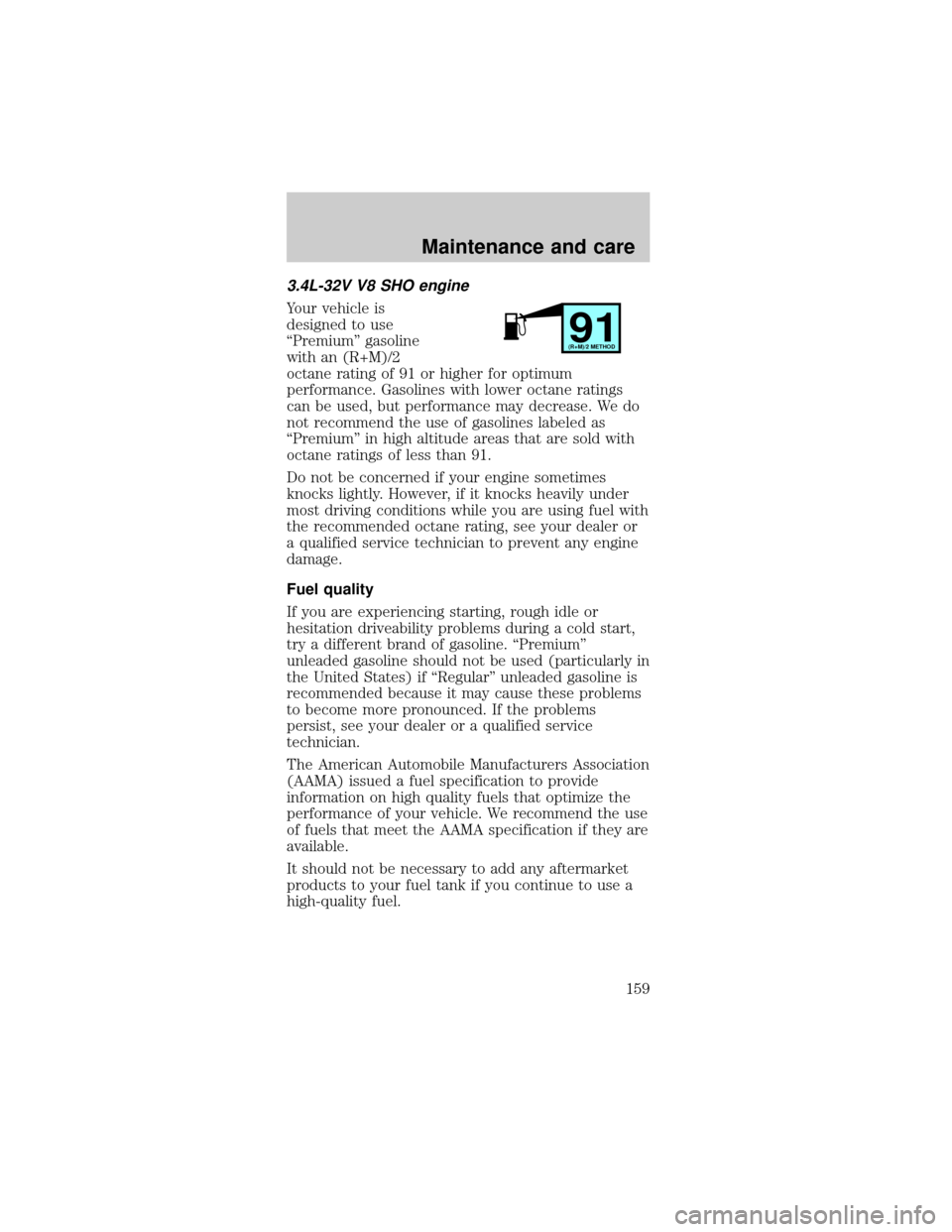
3.4L-32V V8 SHO engine
Your vehicle is
designed to use
ªPremiumº gasoline
with an (R+M)/2
octane rating of 91 or higher for optimum
performance. Gasolines with lower octane ratings
can be used, but performance may decrease. We do
not recommend the use of gasolines labeled as
ªPremiumº in high altitude areas that are sold with
octane ratings of less than 91.
Do not be concerned if your engine sometimes
knocks lightly. However, if it knocks heavily under
most driving conditions while you are using fuel with
the recommended octane rating, see your dealer or
a qualified service technician to prevent any engine
damage.
Fuel quality
If you are experiencing starting, rough idle or
hesitation driveability problems during a cold start,
try a different brand of gasoline. ªPremiumº
unleaded gasoline should not be used (particularly in
the United States) if ªRegularº unleaded gasoline is
recommended because it may cause these problems
to become more pronounced. If the problems
persist, see your dealer or a qualified service
technician.
The American Automobile Manufacturers Association
(AAMA) issued a fuel specification to provide
information on high quality fuels that optimize the
performance of your vehicle. We recommend the use
of fuels that meet the AAMA specification if they are
available.
It should not be necessary to add any aftermarket
products to your fuel tank if you continue to use a
high-quality fuel.
91(R+M)/2 METHOD
Maintenance and care
159
Page 160 of 192
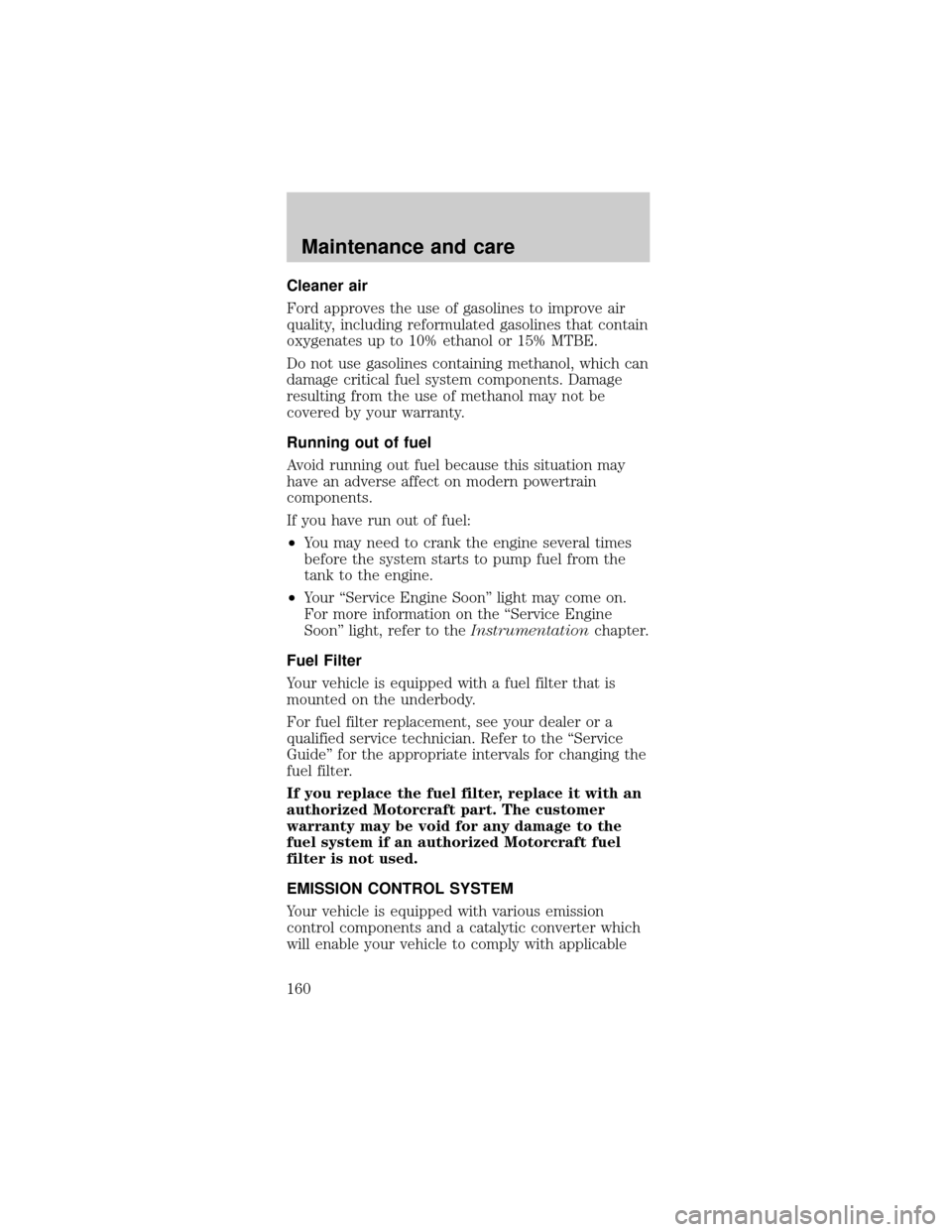
Cleaner air
Ford approves the use of gasolines to improve air
quality, including reformulated gasolines that contain
oxygenates up to 10% ethanol or 15% MTBE.
Do not use gasolines containing methanol, which can
damage critical fuel system components. Damage
resulting from the use of methanol may not be
covered by your warranty.
Running out of fuel
Avoid running out fuel because this situation may
have an adverse affect on modern powertrain
components.
If you have run out of fuel:
²You may need to crank the engine several times
before the system starts to pump fuel from the
tank to the engine.
²Your ªService Engine Soonº light may come on.
For more information on the ªService Engine
Soonº light, refer to theInstrumentationchapter.
Fuel Filter
Your vehicle is equipped with a fuel filter that is
mounted on the underbody.
For fuel filter replacement, see your dealer or a
qualified service technician. Refer to the ªService
Guideº for the appropriate intervals for changing the
fuel filter.
If you replace the fuel filter, replace it with an
authorized Motorcraft part. The customer
warranty may be void for any damage to the
fuel system if an authorized Motorcraft fuel
filter is not used.
EMISSION CONTROL SYSTEM
Your vehicle is equipped with various emission
control components and a catalytic converter which
will enable your vehicle to comply with applicable
Maintenance and care
160
Page 161 of 192
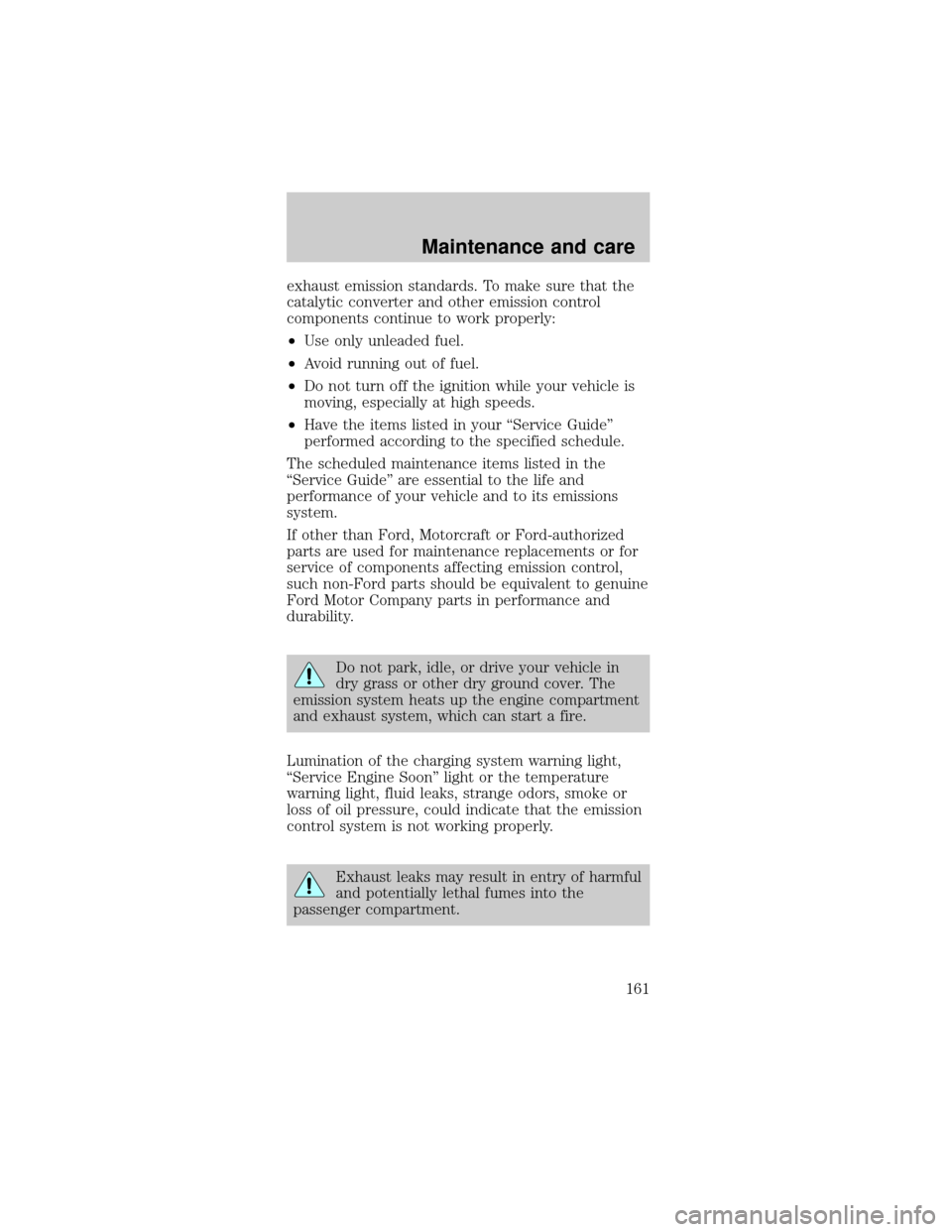
exhaust emission standards. To make sure that the
catalytic converter and other emission control
components continue to work properly:
²Use only unleaded fuel.
²Avoid running out of fuel.
²Do not turn off the ignition while your vehicle is
moving, especially at high speeds.
²Have the items listed in your ªService Guideº
performed according to the specified schedule.
The scheduled maintenance items listed in the
ªService Guideº are essential to the life and
performance of your vehicle and to its emissions
system.
If other than Ford, Motorcraft or Ford-authorized
parts are used for maintenance replacements or for
service of components affecting emission control,
such non-Ford parts should be equivalent to genuine
Ford Motor Company parts in performance and
durability.
Do not park, idle, or drive your vehicle in
dry grass or other dry ground cover. The
emission system heats up the engine compartment
and exhaust system, which can start a fire.
Lumination of the charging system warning light,
ªService Engine Soonº light or the temperature
warning light, fluid leaks, strange odors, smoke or
loss of oil pressure, could indicate that the emission
control system is not working properly.
Exhaust leaks may result in entry of harmful
and potentially lethal fumes into the
passenger compartment.
Maintenance and care
161
Page 162 of 192

Do not make any unauthorized changes to your
vehicle or engine. By law, vehicle owners and anyone
who manufactures, repairs, items, sells, leases,
trades vehicles, or supervises a fleet of vehicles are
not permitted to intentionally remove an emission
control device or prevent it from working.
Information about your vehicle's emission system is
on the Vehicle Emission Control Information Decal
located on or near the engine. This decal identifies
engine displacement and gives some tune up
specifications.
Please consult your ªWarranty Guideº for complete
emission warranty information.
Readiness for inspection/maintenance (I/M)
testing
In some localities, it may be a legal requirement to
pass an I/M test of the on-board diagnostic (OBD-II)
system. If your ªCheck Engine/Service Engine Soonº
light is on, refer to the description in theWarning
Lights and Chimessection of theInstrumentation
chapter. Your vehicle may not pass the I/M test with
the ªCheck Engine/Service Engine Soonº light on.
If the vehicle's powertrain system or its battery has
just been serviced, the OBD-II system is reset to a
ªnot ready for I/M testº condition. To ready the
OBD-II system for I/M testing, a minimum of 30
minutes of city and highway driving is necessary as
described below:
²First, at least 10 minutes of driving on an
expressway or highway.
²Next, at least 20 minutes driving in stop-and-go,
city-type traffic with at least four idle periods.
Allow the vehicle to sit for at least eight hours
without starting the engine. Then, start the engine
and complete the above driving cycle. The engine
must warm up to its normal operating temperature.
Once started, do not turn off the engine until the
above driving cycle is complete.
Maintenance and care
162
Page 170 of 192
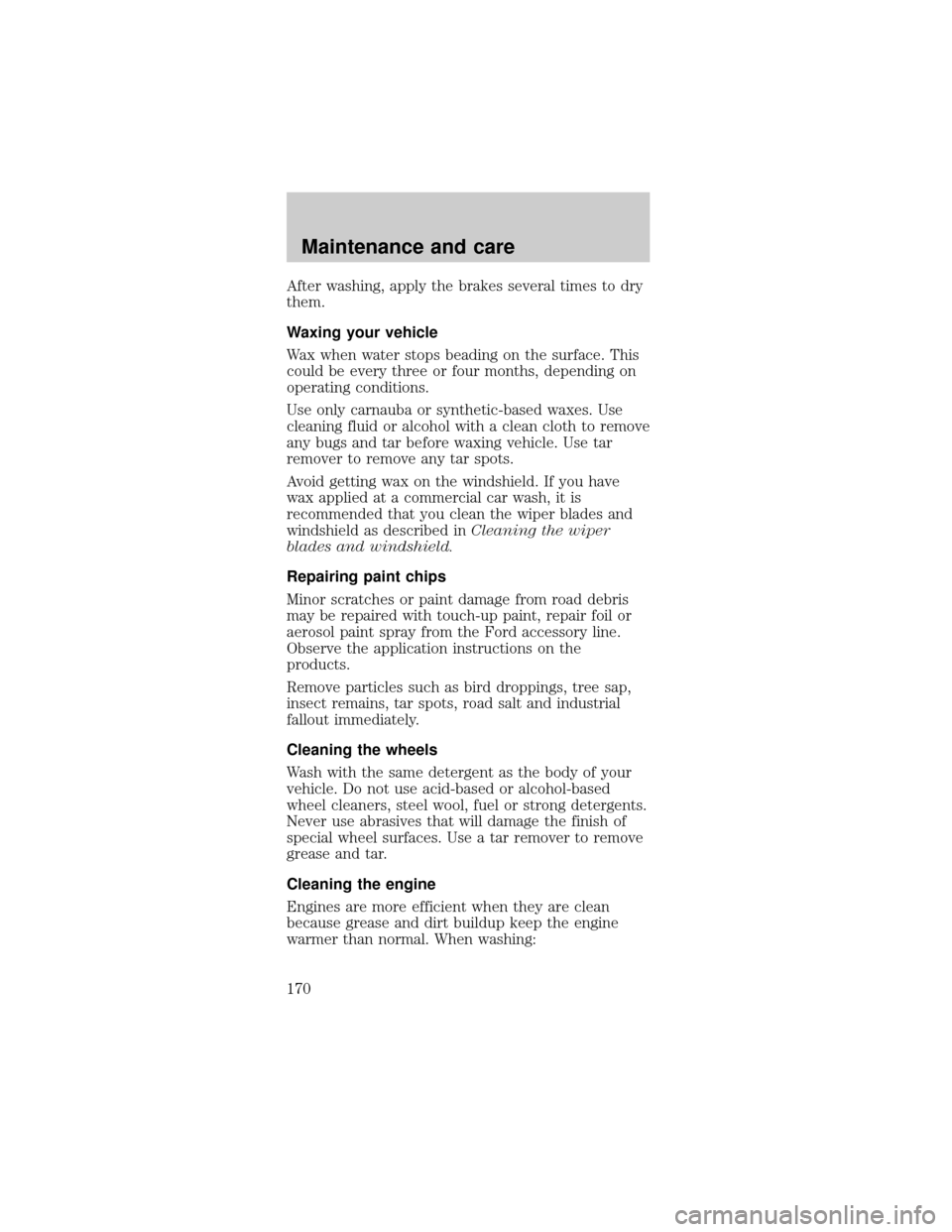
After washing, apply the brakes several times to dry
them.
Waxing your vehicle
Wax when water stops beading on the surface. This
could be every three or four months, depending on
operating conditions.
Use only carnauba or synthetic-based waxes. Use
cleaning fluid or alcohol with a clean cloth to remove
any bugs and tar before waxing vehicle. Use tar
remover to remove any tar spots.
Avoid getting wax on the windshield. If you have
wax applied at a commercial car wash, it is
recommended that you clean the wiper blades and
windshield as described inCleaning the wiper
blades and windshield.
Repairing paint chips
Minor scratches or paint damage from road debris
may be repaired with touch-up paint, repair foil or
aerosol paint spray from the Ford accessory line.
Observe the application instructions on the
products.
Remove particles such as bird droppings, tree sap,
insect remains, tar spots, road salt and industrial
fallout immediately.
Cleaning the wheels
Wash with the same detergent as the body of your
vehicle. Do not use acid-based or alcohol-based
wheel cleaners, steel wool, fuel or strong detergents.
Never use abrasives that will damage the finish of
special wheel surfaces. Use a tar remover to remove
grease and tar.
Cleaning the engine
Engines are more efficient when they are clean
because grease and dirt buildup keep the engine
warmer than normal. When washing:
Maintenance and care
170
Page 171 of 192
²Take care when using a power washer to clean
the engine. The high pressure fluid could
penetrate the sealed parts and cause damage.
²Do not spray with cold water to avoid cracking
the engine block or other engine components.
²Cover the highlighted areas to prevent water
damage when cleaning the engine.
²3.0L Vulcan engine
Maintenance and care
171
Page 172 of 192
²3.0L Duratec engine
²3.4L SHO engine
²Never wash or rinse the engine while it is
running; water in the running engine may cause
internal damage.
Cleaning the engine
Cover the underhood electrical connections and
terminals of your vehicle when cleaning the engine
compartment. Avoid spraying or splashing cleaning
solvents or detergent solutions on the terminals and
connections. After the cleaning is completed and
with the engine not running, remove the protective
cleaning coverings. Exposing electrical connections
and terminals to cleaning solvents and detergent
solutions over a period of time can corrode them
and result in electrical system damage and
malfunctions.
Cleaning plastic exterior parts
Use vinyl cleaner for routine cleaning. Clean with a
tar remover if necessary. Do not clean plastic parts
with thinners, solvents or petroleum-based cleaners.
V8 32 VALVE
Maintenance and care
172